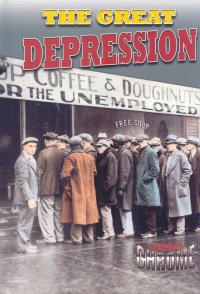| ________________
CM . . .
. Volume XX Number 37. . . .May 23, 2014
excerpt:
After World War I, business was booming, jobs were readily available, and many were investing heavily in the stock market because of their high hopes for the future. On Tuesday, October 29, 1929, the world was shocked when the price of stocks on the American Stock Market started to plunge. As panic spread, a worldwide economic depression began. It lasted 10 years and became known as The Great Depression. The drastic effects of the economic downturn included: family bankruptcies, high unemployment, extreme poverty, hunger, homelessness and drought. Despite these problems, people found many ways to cope. They looked to simple pleasures for comfort. They played games, listened to the radio and went to the movies. Politicians tried to mitigate the economic disaster. President Herbert Hoover started building programs such as the Hoover Dam to get people back to work. However, Americans felt more drastic change was needed. In 1933, Franklin D. Roosevelt was elected. His “New Deal” was a plan to improve the economy by giving food, housing and employment to millions of workers. In Canada, R. B. Bennett proposed his own “New Deal.” However, it was not until the economic boost of World War II that the Great Depression finally ended. Robin Johnson’s The Great Depression is part of the “Crabtree Chrome” series which is designed for middle grade students reading at Fontas and Pinnell levels L-M. The Crabtree website states that “The series helps struggling readers build background knowledge, vocabulary and experience reading success through highly engaging and timely topics.” The Great Depression will appeal to young readers for many reasons. It is full of colourful graphics, photographs, interesting facts and useful text features, such as a bibliography, glossary and index. Not only does the writer give readers information on the causes and results of the economic downturn, but she also gives young readers a sense of the psychological and emotional toll that poverty and desperation had on families. The Great Depression is a useful text for young readers who want a general overview of this important historical period. It focuses primarily on events in the United States with some limited information about Canadian events. The final section, “The Economy Today”, is particularly interesting because it compares the Great Depression to modern-day economic downturns. Recommended. Myra Junyk, of Toronto, ON, is a literacy advocate and author.
To comment
on this title or this review, send mail to cm@umanitoba.ca.
Copyright © the Manitoba Library Association. Reproduction for personal
use is permitted only if this copyright notice is maintained. Any
other reproduction is prohibited without permission.
NEXT REVIEW |
TABLE OF CONTENTS FOR THIS ISSUE
- May 23, 2014.
AUTHORS |
TITLES |
MEDIA REVIEWS |
PROFILES |
BACK ISSUES |
SEARCH |
CMARCHIVE |
HOME |
